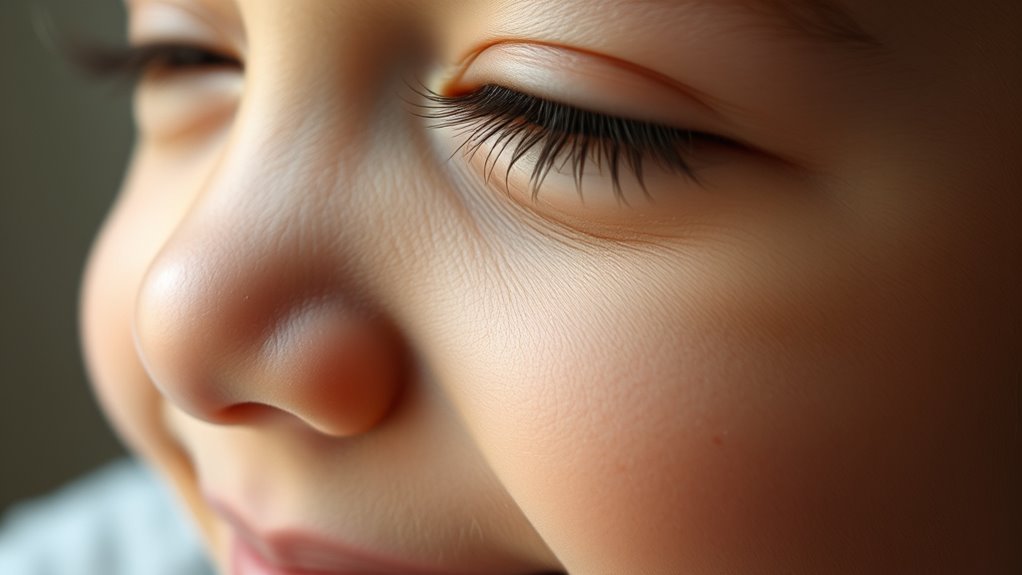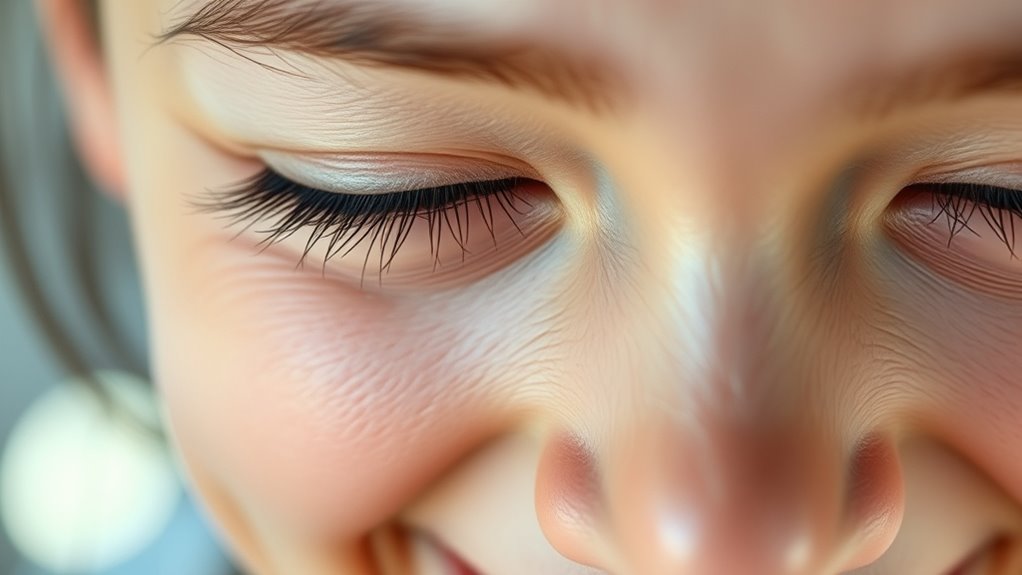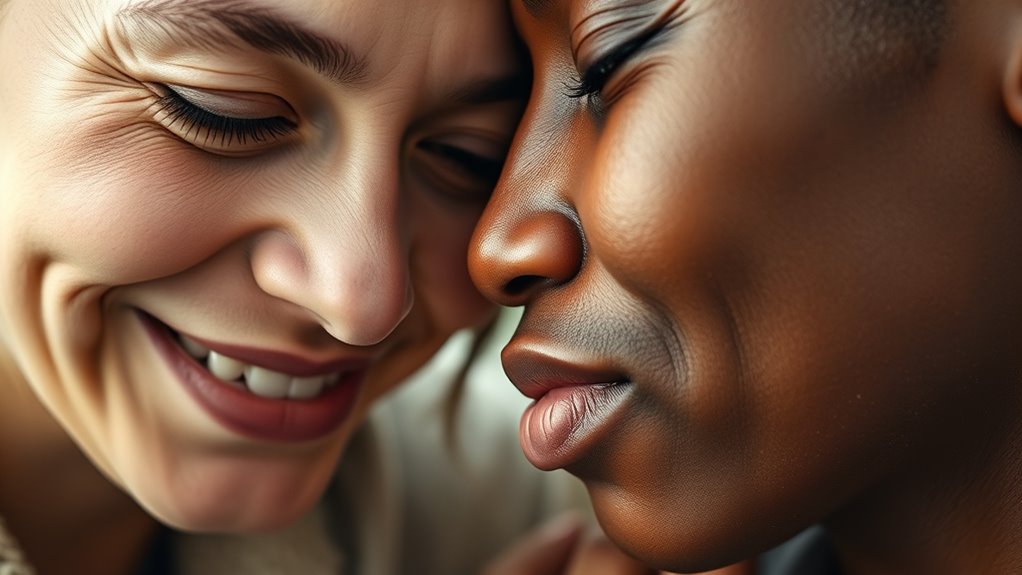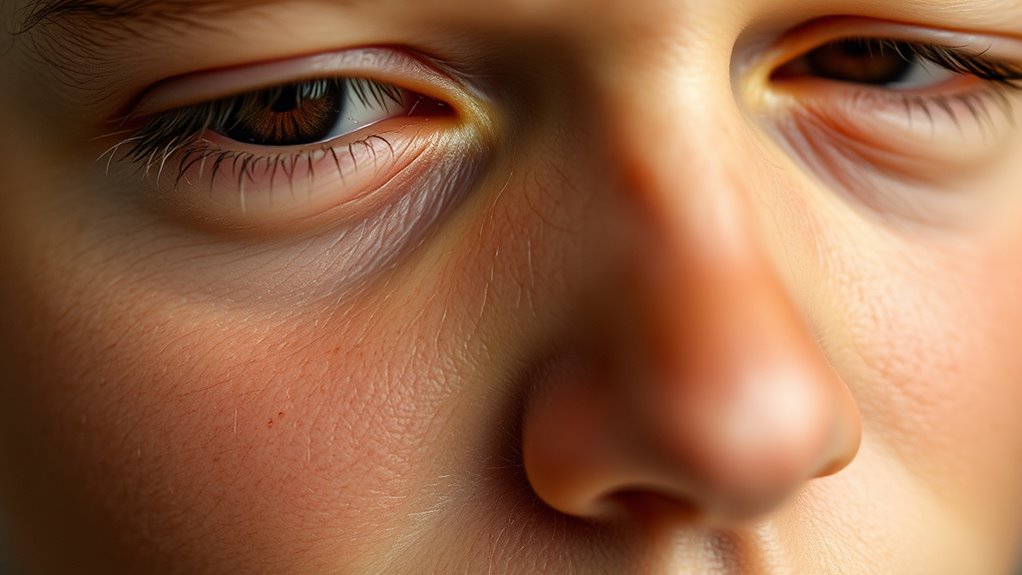Micro-expressions are tiny, involuntary facial gestures that reveal genuine feelings, including care and concern often hidden by words. By noticing subtle muscle movements around the eyes and mouth, you can detect authentic emotions, strengthening your social bonds. Recognizing these quick signals can help you understand others better and build trust. If you keep exploring, you’ll find ways to improve your ability to interpret these meaningful, small gestures that show care.
Key Takeaways
- Micro-expressions reveal genuine emotions like concern or compassion through brief facial muscle movements.
- Recognizing micro-expressions helps identify subtle signs of care and empathy in others.
- Small gestures such as eye contact, a slight smile, or a caring look can be micro-expressions of kindness.
- Cultural awareness enhances understanding of micro-expressions that demonstrate care across different societies.
- Practicing observation of micro-expressions improves interpersonal connection and shows authentic concern.
Understanding Micro-Expressions and Their Significance

Understanding micro-expressions is essential because these fleeting facial signals reveal true emotions that people often try to hide. By honing your micro expression training, you can better interpret these quick flashes of genuine feeling. Recognizing micro-expressions helps you see beyond words, offering insight into someone’s real thoughts and emotions. Keep in mind, cultural expression influences how micro-expressions are displayed and understood; some gestures may vary across cultures, but many are universal. Developing this skill enhances your social perception and communication. When you learn to read these subtle cues accurately, you gain a powerful tool for building trust, detecting deception, and improving relationships. Mastering micro-expressions ultimately allows you to connect more deeply and respond more empathetically in various social and professional settings.
The Types of Micro-Expressions and What They Reveal

Micro-expressions come in several distinct types, each revealing different layers of emotional truth. You can observe these variations by noting how facial muscles subtly shift, often outside conscious awareness. Recognize these key types:
- Simulated Expressions: Fleeting flashes without genuine emotion, often used to hide feelings.
- Neutralized Expressions: Suppressed genuine reactions, resulting in a blank or neutral face.
- Masked Micro-Expressions: A micro-expression that contradicts the true emotion, revealing hidden feelings.
- Universal Emotions: Expressions that signal fear, sadness, or joy, often consistent across cultures.
Keep in mind that cultural variations influence how facial muscles move and how micro-expressions are displayed. Recognizing these differences can improve your understanding of others’ true emotions. Additionally, integrating advanced AI tools can assist in more accurately detecting and analyzing micro-expressions for deeper insights.
How Micro-Expressions Enhance Our Social Perception

By learning to spot micro-expressions, you can uncover hidden emotions that people might try to hide. Recognizing these brief signals helps you communicate more effectively and respond appropriately in social interactions. As a result, you can build trust faster and strengthen your interpersonal connections with greater insight. Additionally, understanding subtle cues such as tiny gestures on water can reveal underlying feelings, enhancing your overall social perception.
Spotting Hidden Emotions
Micro-expressions act as quick secret signals that reveal what someone truly feels, even when they try to hide it. Recognizing these fleeting expressions helps you spot hidden emotions others may conceal. With micro expression training, you learn to identify subtle facial cues that betray genuine feelings. Facial muscle analysis plays a vital role in this process, as specific muscle movements correspond to different emotions. To sharpen your skills, focus on:
- Observing rapid changes in facial expressions
- Noticing inconsistencies between words and micro-expressions
- Paying attention to micro-movements around the eyes and mouth
- Practicing regularly with high-speed video tools
- Developing an understanding of emotional recognition to better interpret subtle cues.
Improving Interpersonal Skills
Understanding subtle facial cues can considerably boost your social perception and interpersonal skills. Recognizing micro-expressions helps you interpret genuine emotions behind words, fostering empathy and connection. Micro expressions and culture influence how emotions are displayed and perceived, so being aware of these nuances improves cross-cultural interactions. Additionally, micro expressions in art reveal authentic emotional states, enriching your appreciation and understanding of artistic intent. To grasp their significance, consider this table:
| Micro-Expressions | Cultural Variations | Art Interpretations | Emotional Signals | Detection Techniques |
|---|---|---|---|---|
| Genuine Joy | Varies by culture | Convey sincerity | Happiness | High-speed cameras |
| Suppressed Guilt | Cultural norms | Reveal hidden feelings | Shame | Micro-moment analysis |
| Masked Anger | Cultural display rules | Show underlying tension | Frustration | Facial muscle cues |
| Subtle Sadness | Cultural expressions | Add depth to art | Melancholy | Rapid observation |
| Fleeting Surprise | Cultural differences | Capture authentic emotion | Shock | Real-time detection |
Mastering these cues enhances your social skills and cultural sensitivity. Developing an awareness of non-verbal communication further amplifies your ability to interpret micro-expressions accurately.
Building Trust Quickly
Building trust quickly hinges on your ability to read subtle emotional cues that reveal genuine intentions. Micro expression calibration helps you fine-tune your perception, making it easier to spot authentic feelings beneath surface behaviors. Recognizing cultural micro expressions ensures you interpret emotions accurately across different backgrounds, avoiding misunderstandings. To build trust faster, observe:
- Small facial movements indicating sincerity
- Consistent micro-expressions matching spoken words
- Genuine emotional responses, not masked ones
- Micro expressions that reveal hidden doubts or discomfort
- Being aware of Relationship dynamics can help you better understand and respond to subtle emotional signals in social interactions.
Key Research and Studies on Micro-Expressions

Research on micro-expressions has uncovered how they can reveal hidden emotions, even when people try to hide them. Foundational experiments, like those by Ekman and Friesen, demonstrate their potential in detecting deception and emotional states. Recent studies also connect these fleeting expressions to specific brain activity, highlighting their biological basis. Additionally, understanding the influence of astrological signs on personality traits may help interpret subtle emotional cues during interpersonal interactions.
Foundational Experiments
Key studies on micro-expressions have particularly shaped our understanding of their role in nonverbal communication. Researchers used innovative experiments to analyze micro movement patterns and facial muscle activation, revealing how brief expressions reveal genuine emotions. For example, Ekman and Friesen’s work involved high-speed cameras to capture involuntary facial responses during interviews. They identified specific facial action units linked to universal emotions, emphasizing the importance of muscle activation in micro-expressions. Haggard and Isaacs’ experiments introduced slow-motion video analysis, allowing detailed observation of fleeting facial movements. These foundational studies confirmed that micro-expressions are involuntary, rapid, and tied to emotional states. They established the basis for modern detection techniques and emphasized the importance of understanding facial muscle activation patterns in authentic emotional expression. Additionally, advancements in AI and automation have led to the development of intelligent tutoring systems, which analyze facial cues to tailor learning experiences, highlighting the expanding role of micro-expressions in technology.
Brain-Expression Links
Studies have demonstrated a direct connection between brain activity and micro-expressions, revealing how specific neural mechanisms produce these fleeting emotional signals. Research shows that neural pathways involved in emotional processing, such as the amygdala, activate rapidly during emotional responses, influencing facial muscle movements. fMRI studies identify brain regions like the prefrontal cortex working in tandem with facial motor pathways, creating micro-expressions. These quick signals reflect real-time neural activity, often bypassing conscious control. Understanding these links helps decode hidden emotions and improve detection accuracy. Here’s a snapshot of key neural components involved:
| Brain Region | Function | Role in Micro-Expressions |
|---|---|---|
| Amygdala | Emotional processing | Initiates rapid emotional response |
| Prefrontal Cortex | Decision-making and regulation | Modulates expression display |
| Motor Cortex | Facial muscle control | Executes micro-expressions |
Additionally, ongoing research continues to uncover neural mechanisms that underpin these subtle cues, enhancing our ability to interpret emotional states more accurately.
The Brain’s Role in Generating Micro-Expressions

The brain plays a crucial role in producing micro-expressions by rapidly processing emotional stimuli and triggering specific neural pathways that control facial muscles. When you experience an emotion, brain activation occurs in regions like the amygdala and cerebral cortex, which coordinate facial muscle movements. These neural signals activate action units (AUs), the fundamental facial muscle movements responsible for micro-expressions. This process is influenced by the brain’s ability to foster mindfulness and emotional awareness, which can affect the frequency and authenticity of micro-expressions. Key points include:
- Brain activation in emotion-related areas
- Neural pathways controlling facial muscles
- Quick communication between brain and muscles
- Activation of specific action units (AUs)
This rapid neural response results in involuntary facial muscle movements that reveal genuine emotions. Understanding how the brain orchestrates these micro-expressions helps explain their authenticity and fleeting nature, making them a powerful tool for emotional insight.
Practical Uses of Micro-Expressions in Daily Life and Professions

Micro-expressions serve as valuable tools across various daily interactions and professional settings, helping you read underlying emotions that might not be verbally expressed. By mastering Micro Expression Art, you can interpret subtle facial cues, gaining deeper insight into others’ true feelings. In professions like psychology, law enforcement, and negotiation, facial micro analysis becomes essential for detecting deception and understanding unspoken concerns. Recognizing micro-expressions enhances your social skills, allowing you to respond more empathetically and build trust. Even in everyday conversations, spotting a fleeting micro-expression can reveal genuine reactions, helping you navigate relationships more effectively. When you learn to read these small gestures accurately, you strengthen communication, foster empathy, and make more informed decisions. Additionally, understanding the impact of contrast ratio on image quality can deepen your appreciation for visual cues and nuances in various contexts.
Recognizing Genuine Emotions Through Micro-Expressions

Recognizing genuine emotions through micro-expressions requires keen observation and an understanding of their subtle cues. To do this effectively, consider cultural variations, as expressions may differ across cultures, affecting interpretation. Micro Expression Training can sharpen your skills, helping you distinguish authentic feelings from false displays. Keep an eye out for:
Master micro-expressions by observing subtle cues and cultural differences to identify genuine emotions accurately.
- Rapid changes in facial muscles indicating true emotions
- Inconsistencies between words and micro-expressions
- Micro-gestures that reveal concealed feelings
- Cultural differences influencing expression patterns
Challenges in Detecting and Interpreting Micro-Expressions

Detecting and interpreting micro-expressions can be surprisingly challenging because these fleeting signals often escape notice even for trained observers. One common obstacle is debunking micro expression myths that suggest they are always clear or easy to read; in reality, many micro-expressions are subtle and require careful observation. Cultural differences also complicate interpretation, as facial expressions and their meanings can vary across cultures, leading to misjudgments. Additionally, high-speed cameras and technology help but aren’t foolproof, and context is essential for accurate reading. You must also consider individual variability—what signals emotion in one person might not in another. These factors make the task complex, demanding patience, skill, and awareness of cultural nuances to avoid misinterpretation.
Developing Skills to Read Micro-Expressions Effectively

To effectively read micro-expressions, you need to develop keen observational skills and train your attention to detail. Micro expression training helps you recognize subtle facial cues quickly. Focus on improving facial muscle control to detect fleeting movements that reveal true emotions. Practice regularly with high-quality images or videos to sharpen your skills. Consider these tips:
- Study facial action units (AUs) linked to specific emotions
- Observe micro-expressions in different contexts and cultures
- Use slow-motion analysis to spot brief expressions
- Record and review your own observations to improve accuracy
Frequently Asked Questions
Can Micro-Expressions Be Voluntarily Controlled or Suppressed?
You can attempt voluntary control or suppression of micro-expressions using techniques like facial muscle control or deliberate relaxation. However, micro-expressions are involuntary and often fleeting, making them difficult to fully suppress. Skilled observers and specialized technology, like high-speed cameras, can detect these subtle signs despite your suppression efforts. So, while you may try to control or mask micro-expressions, complete suppression remains challenging due to their involuntary nature.
Are Micro-Expressions Consistent Across Different Cultures?
Did you know that studies show 90% of micro-expressions are universally recognized? When it comes to cultural variations, micro-expressions tend to be quite consistent across different cultures, making them a powerful tool for cross-cultural communication. You can rely on these fleeting facial cues to understand others’ true emotions, regardless of cultural background, enhancing your social perception and helping you navigate diverse interactions more effectively.
How Long Does It Typically Take to Learn Micro-Expression Recognition Skills?
You can typically learn micro-expression recognition skills in a few weeks to a few months, depending on your training duration and learning curve. Consistent practice with high-speed videos, online courses, or expert feedback accelerates your progress. While some may grasp these skills quickly, others might need more time to develop accuracy. Stay committed, practice regularly, and you’ll enhance your ability to detect micro-expressions effectively.
Are There Technological Tools That Can Automatically Detect Micro-Expressions?
Yes, several technological tools can automatically detect micro-expressions using facial recognition and emotion detection algorithms. These systems analyze subtle facial movements in real-time or from video footage, helping you identify genuine emotions quickly. Advanced software leverages high-speed camera data and AI to enhance accuracy, making it easier for you to interpret underlying feelings, whether for security, psychology, or social interactions. These tools boost your ability to read emotions effectively and efficiently.
Can Micro-Expressions Be Used Effectively in Virtual or Online Communication?
Yes, micro-expressions can be effectively used in virtual communication by paying close attention to subtle virtual cues like facial movements and eye contact. You can read online impressions more accurately by observing these fleeting signals, which reveal true emotions beyond words. Using high-quality video helps detect micro-expressions, improving your social perception and interaction skills, even when face-to-face contact isn’t possible.
Conclusion
By learning to notice micro-expressions, you open your eyes to hidden emotions, deepen your connections, and enhance your understanding. Recognize genuine feelings, interpret subtle cues, and build trust through awareness. Develop your skills to see beyond words, to read beyond gestures, and to understand beyond surface appearances. When you master micro-expressions, you not only improve your perceptions but also enrich your interactions, making your relationships more genuine, more meaningful, and more empathetic.










